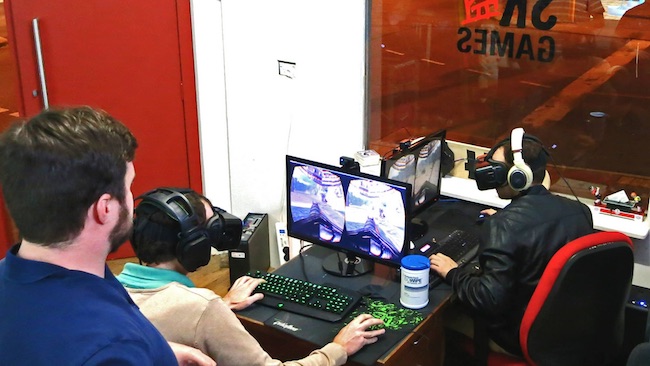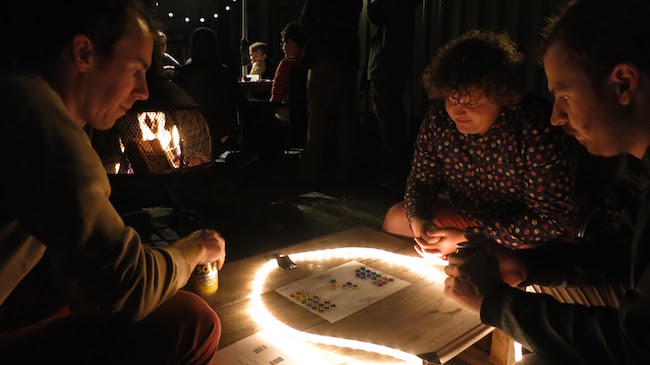
It’s always exciting going hands-on with the latest creative projects from Perth’s best and brightest. But in saying that, there is something especially rewarding in having past games revisit and seeing the evolution that has taken place; in some cases, based directly on feedback received from these sessions. For those who aren’t aware, Playup Perth is a monthly playtesting event, but it also alternates between an all-ages session and an after-dark session – hosted in conjunction with SK Games. Last week, it was Playup’s 4th After Dark event (complete with cheap drinks, of course), where more than 40 people passed through to playtest a variety of video and tabletop games, as well as a unique interactive audio experience that was visiting over from Melbourne. Three of the main games on show had also been featured at past events, and it was clear when speaking with the creators that these sessions had been very helpful.
If you missed out on the event, don’t fret as we’ve so kindly put together a report on each game and how it’s evolved:
Bramblelash
Personally, I’m a big fan of local co-op, so it was fantastic to have Liam and Sam from ByteSprite visiting with us again. Of all the games on show, this was definitely the one which had taken the most influence from the previous session and had seen a massive leap forward in just a number of weeks. If you didn’t get a chance to check it out at either event, basically it’s a game where players work together while linked with a tether to survive waves of enemies and complete objectives. On display this time, though, was an all-new 4-player multiplayer mode which pitted teams of two against each other; which to no surprise was a lot of fun, especially for those already familiar with the game.
Getting a chance to speak with Liam on the night, we chatted about all the updates and new additions to the game. In particular, obstacles was one the most requested features from the last session, so, in the multiplayer mode, we got to see this in the way of pillars that players could get caught on, as well as a patch of brambles in the middle which could only be crossed by players working together to fling the other across using the tether. Popular feedback also included adding in more levels, to which Liam announced on the night that there were now 10 levels planned for the final release. The ambition behind this game has certainly grown quickly, as I was surprised to learn the game would now feature a core adventure mode, with various levels, win conditions and bosses, as well as an endless mode which would be unlocked at the end. I also noted several new enemy designs and a few minor graphical updates too.
For more info on Bramblebash, or to try out the demo, jump on over to the official website: bytespritegames.com

Suburban Encounter (working title)
As a long-time fan of Settlers of Catan, I’m usually pretty keen to go hands-on with any game that involves city building. So, on the night, it’s no surprise I took an interest in Kai Ashford-Hatherly, Kit Matthews and Rob Lemmon new tabletop game, Suburban Encounter. Admittedly, I’m not someone who gets involved in tabletop regularly as my time is mostly focused on video games, but in saying that, I appreciate any game built around solid fundamentals.
To expand upon the premise game, Suburban Encounter is a tile-based game that focuses on competitive building, bidding against other players, teaming up, and, ultimately, trying to build a particular “shape” with your property development in order to win. There are 4 core structures you can build: parks, houses, factories, and shops. At the beginning of each turn, you go into the bidding to build a structure of your choosing, expanding either north, south, east or west. Assuming you have the cash and are unopposed in your direction, you can build. Successfully building can help to earn you more money per turn, and should you position the right structures next to each other, you can combine them to form complexes and then quads. Money is important, because should someone else bid in the same direction, you are going to need to front up the cash or team up with someone else to win that real estate.
Supporting up to 6 players without any complicated setup is always great, and with games that last between 30-45 minutes on average, it’s not something that outstays it’s welcome like a frustrating session of Monopoly. It’s relatively easy to start, given someone experienced is explaining, and it also has a lot of small nuances to facilitate advanced tactics. Being our first playtest session, there were a few stumbling blocks and things still to be tightened up, but overall the game is already showing promise despite only being a collection of coloured cardboard and plastic tokens.
There is no official blog just yet, but you can look forward to it making a return at future Playup events. Stay tuned!

Valiant
Valiant is a game I have personally been following long before it was a VR title. In fact, when I first played it, it was simply titled “Horse Wars.” Oculus Rift integration was just an idea for a feature back then, which is super cool when you think about it as it’s now the leading VR title being developed in Perth and has received a positive interest online from all corners of the globe. To explain Valiant, it is, roughly speaking, a class-based, competitive arena game, with players fighting on horseback. Imagine Chivalry, but riding on horses with lances, swords, and bows and arrows.
Valiant made its public debut as a VR game at the Perth Games Festival last year, and, since that time, the dev team has mostly been focused on polishing the game with improvements to the hud, bug fixes and introducing 3D audio. However, there is still one big challenge the team at Offpeak Games must overcome, and that’s motion sickness. You see, when trying to turn while moving at fast speeds on horseback, the motion of this action starts to confuse your brain as your view and position is shifting quickly, but your body is well aware that it’s not actually moving. Trialing comfort modes has been the biggest step forward for Valiant the past several months, and on the night, the team was playtesting with three different options. Personally speaking, I find the default setting easiest to play, but I do get sick, and I’m not yet convinced on the alternative of manually controlling the camera with quick snaps or drag options. It’s definitely going to be tough to hit a good spot, but I’m confident the team will continue to work hard on getting it right.
On the night, I also got to chat with the lead game designer, Christopher Parkin. While the current version in the polishing stage, Chris was still eager to discuss the potential of new modes which could grow from the current build given the time between now and when the VR audience has grown. Personally, I’m keen to see a PVP jousting mode, as it involves accuracy and charging in a straight line; which not only compliments skill building for the core game, but also isn’t affected by the motion issue. It’s fun to speculate, and we look forward to seeing Valiant again in the future.
If you’d like to follow the game’s progress, or try it out for yourself, you can find more info at: http://valiantgame.com

Flip Flop and Tiny Castles
Eeshwar Rajagopalan is a regular guest on the Playup Roster, who I believe is studying engineering and has an affinity for developing tabletop games which are easy to pick up and play. On the night, Eeshwar had bought back a game we previously tested called “ThirtySix,” but in two new forms: “Flip Flop Numbers” and “Flip Flop Attack.”
To explain, “Numbers” is a 2-player tile placement game that focuses on the strategic positioning of tiles. Basically, you want to place your tiles in a way to flip them and your opponents to come out on top; hence, the title: Flip Flop. “Attack,” on the other hand, is a more fast-paced version where you push, flip and slide your opponents tiles off the board before they can do the same to you. Of the two, Numbers is the most polished version, having evolved from the dice-based ThirtySix at the last Playup. It’s clear that player feedback has strongly influenced Eeshwar to focus in on the fundamentals of the game, and to create a more elegant and simple experience overall. It definitely appears to be moving in a promising direction! Being the first test for Attack, however, it’s evident the variation still requires a little more work to balance the mechanics. We look forward to seeing whether it will find its legs in the coming months.
In addition, a new game called Tiny Castles was also brought along this week, which was a product of Eeshwar’s time spent at the recent Level One Popup Co-Working Space for Game Makers. Essentially, it is a 2-4 player worker placement game where you try and fill up your castle with treasure by stealing it from other player’s castles – while also trying to stop them from stealing from your own castle. Using three unit types: soldiers, thieves, and adventurers, players must try to collect six treasures either by stealing them or adventuring. Overall, feedback indicated the stealing component was well received, either by thieving or attacking the other players castle, but the adventuring component didn’t quite capture the players interest. Eeshwar explained that the next iteration of the game will be focused more heavily on the first two components, so we’re looking forward to seeing how Tiny Castles evolves at future Playups.

And, That’s a Wrap!
As far as the session went, I think it was arguably the most rewarding so far as we had so many games making a return. It gives participants the perception that their feedback can actually make a difference, and that is a truly fantastic thing. It was also really cool that we had two games visiting from over east: “Flaps” and “Secret Sounds.”
Alex Perrin’s “Flaps” is a very elegant and highly competitive game that involves fighting it out as two rival umbrellas, if that can possibly make sense. It was a surprising amount of fun! And then there was “Secret Sounds,” which is the aforementioned interactive audio experience I mentioned. Basically, it involved sitting in a tent with headphones and waving a move controller to explore a randomly generated soundscape. It was definitely “out there” as I’m sure I discovered what sounded like a pig eating cereal and a man and a women “exercising” together. It was good for a laugh, and a great show of creativity from the Melbourne trio, Harrison Smith, Amani Naseem and Lee Shang Lun.
As always, I’d like to extend a big thank you on behalf of Playup Perth, SK Games and GameCloud Australia.
if you have helped to test any of these games, we appreciate your contributions. And, if you’re keen for more, there’s word of a special-edition Playup this month, which you can RSVP for here. But be quick, tickets are very limited!











